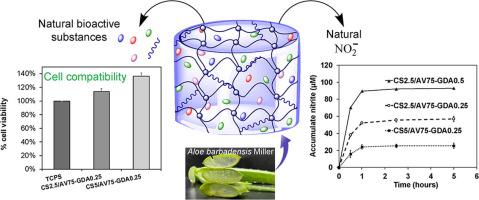Journal of Industrial and Engineering Chemistry ( IF 6.1 ) Pub Date : 2021-07-24 , DOI: 10.1016/j.jiec.2021.07.029 Thai Thanh Hoang Thi 1, 2 , Binh D.T. Trinh 3, 4 , Phuong Le Thi 5 , Dieu Linh Tran 5 , Ki Dong Park 5 , Dai Hai Nguyen 1, 2

|
Because of the toxic glutaraldehyde, the chitosan-glutaraldehyde hydrogels are seriously limited in biomedical applications. In this study, exploiting bioactive compounds of Aloe barbadensis Miller, the chitosan/Aloe barbadensis Miller-glutaraldehyde (CS/AV-GDA) hydrogels were fabricated with 4-fold lower glutaraldehyde concentration without compromising hydrogel characteristics. The gelation time was controlled from a few seconds to several hours. The elastic modulus was varied from 483 to 99940 Pa. The CS/AV-GDA hydrogels could release the natural nitrite amount from 24.0 to 89.6 M within the first hour for antibacterial activity, then continuously deliver a few M every next hour for cell activities. The antibacterial test against Escherichia coli and Staphylococcus aureus revealed that the CS/AV-GDA hydrogels could kill the planktonic bacteria 5-fold more highly than control and prevent bacteria attachment on hydrogel surface effectively. Although the CS/AV-GDA hydrogels consumed only 0.25% glutaraldehyde concentration, their antibacterial capacities were comparable to chitosan-only hydrogels with 2% glutaraldehyde. For cytotoxicity tests, the CS/AV-GDA hydrogels using 0.25% glutaraldehyde concentration induce the human dermal fibroblasts proliferation significantly. All CS/AV-GDA hydrogels with glutaraldehyde crosslinker less than 1% showed non-cytotoxicity. As a result, the new CS/AV-GDA hydrogels might become an attractive candidate for medicine regeneration and tissue engineering.
中文翻译:

自抗菌壳聚糖/库拉索芦荟米勒水凝胶释放亚硝酸盐用于生物医学应用
由于戊二醛的毒性,壳聚糖-戊二醛水凝胶在生物医学应用中受到严重限制。在这项研究中,利用库拉索芦荟的生物活性化合物,在不影响水凝胶特性的情况下,以低 4 倍的戊二醛浓度制造壳聚糖/库拉索米勒-戊二醛 (CS/AV-GDA) 水凝胶。胶凝时间控制在几秒到几小时之间。弹性模量从 483 到 99940 Pa。CS/AV-GDA 水凝胶可以释放天然亚硝酸盐的量从 24.0 到 89.6M 在第一个小时内进行抗菌活性,然后连续输送一些 每隔一小时进行一次细胞活动。对大肠杆菌和金黄色葡萄球菌的抗菌试验揭示CS / AV-GDA水凝胶可以比对照高5倍地杀死浮游细菌,并有效地防止细菌附着在水凝胶表面。尽管 CS/AV-GDA 水凝胶仅消耗 0.25% 的戊二醛浓度,但它们的抗菌能力与仅含 2% 戊二醛的壳聚糖水凝胶相当。对于细胞毒性测试,使用 0.25% 戊二醛浓度的 CS/AV-GDA 水凝胶显着诱导人真皮成纤维细胞增殖。戊二醛交联剂低于 1% 的所有 CS/AV-GDA 水凝胶均显示出非细胞毒性。因此,新的 CS/AV-GDA 水凝胶可能成为药物再生和组织工程的有吸引力的候选者。



























 京公网安备 11010802027423号
京公网安备 11010802027423号